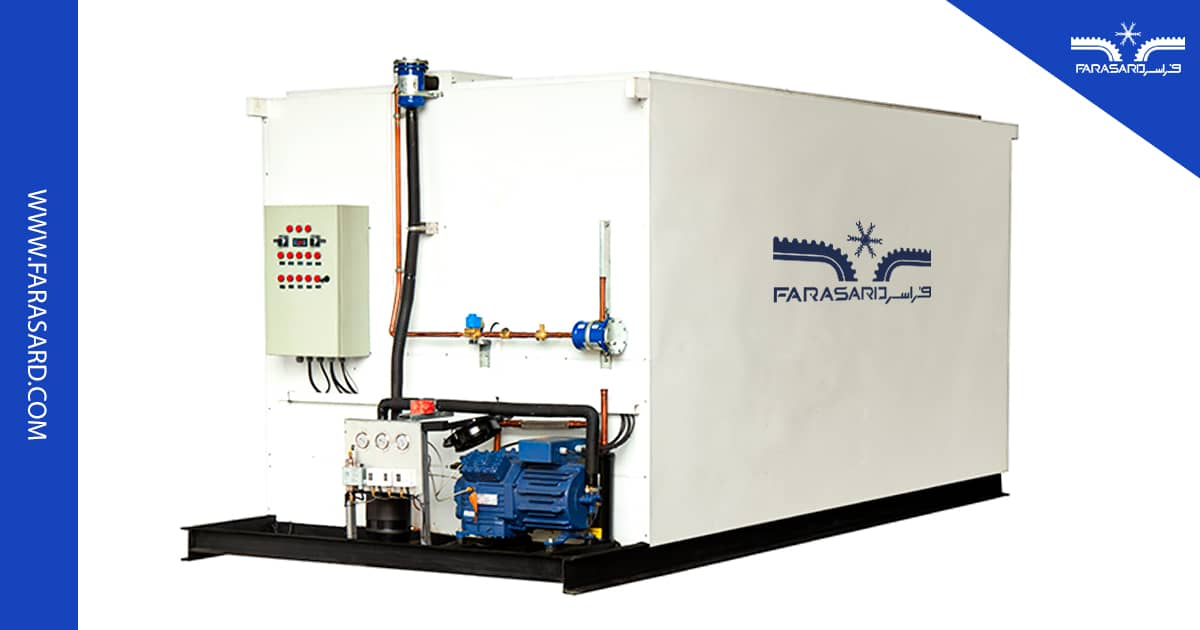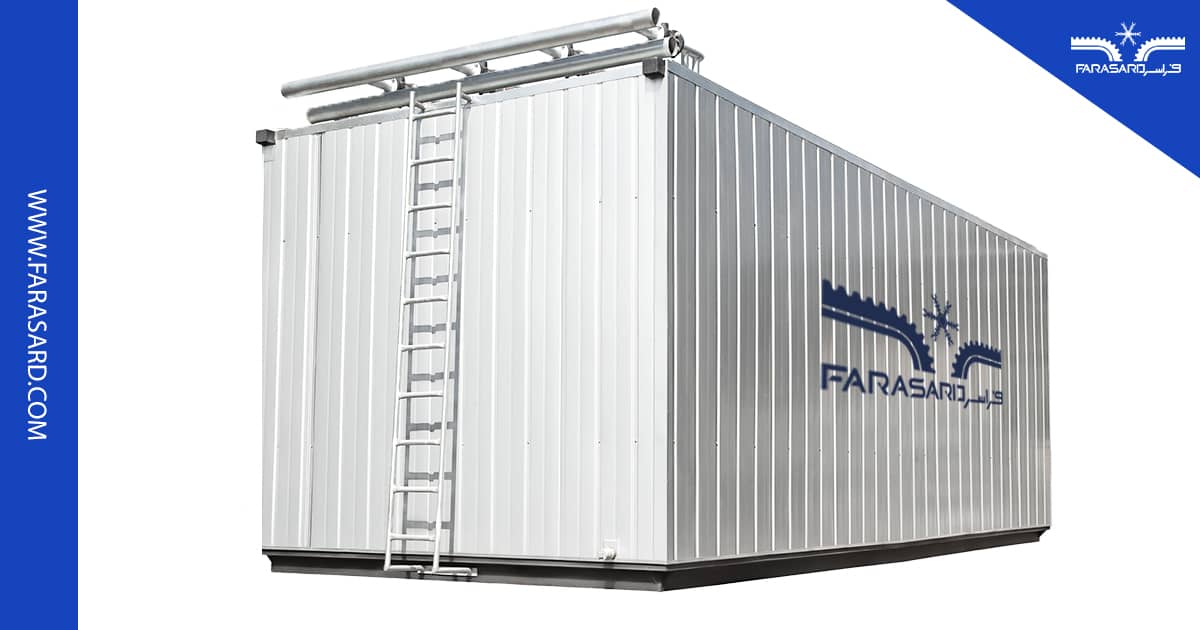


Ice Bank Price + Ice Bank Production and Sale
- Designed and Manufactured by Farasard
- Ice Bank for Dairy and HVAC
- Available in Various Capacities
- Comes with Warranty and After-sales Services
To understand the factors influencing the price of an ice bank, it’s essential to first familiarize yourself with some basic concepts in this regard. Afterwards, we will discuss more about the price, usage, and benefits of an ice bank.
What is an Ice Bank?
Ice Bank or Thermal Ice Storage is a thermal energy storage system based on storing energy in the form of ice during the night and utilizing it during the day.
This technology offers a versatile solution applicable in various industrial settings. The more fluctuation in load and changes in demand throughout the day, the more cost-effective the implementation of Ice Banks becomes.
With increasing environmental concerns, global warming, and rising energy costs, many companies worldwide have increasingly prioritized the use of Ice Banks in their operations.
Types of Ice Banks
To understand the price of an Ice Bank, you need to familiarize yourself with its various classifications; there are two different types of categorization for Ice Banks, which we will examine in detail below.
Classification Based on Design
-
Ice Bank with Internal Melting System
Ice Banks with an Internal Melting System have a simpler design compared to other types.
In this system, there is only one fluid cycle that is used both for storing energy in the Ice Bank and for energy consumption.
In the Internal Melting System, when the system is in the energy storage mode (off-peak hours), the refrigeration system, which in industrial applications mostly consists of centrifugal chillers, sends the chilled fluid into the Ice Bank. As this fluid passes through the pipes inside the Ice Bank, it causes the water inside the compartment to freeze.
It is obvious that in this state, the temperature of the fluid entering the Ice Bank must be below zero degrees Celsius. During peak consumption hours and when the system requires energy, the fluid circulates between the pipes of the Ice Bank and the target point that requires cooling.
The ice formed around the internal pipes during energy storage begins to melt from within when a fluid with a temperature higher than zero degrees Celsius passes through. For this reason, this type of system is referred to as an Ice Bank with Internal Melting System.
The control system of an Ice Bank with internal melting is complex and requires automatic valves to replace the fluid circulation cycle. In contrast, the water inside the reservoir remains constant and does not become contaminated over time.
-
Ice Bank with External Melting System
The Ice Bank with External Melting System features two fluid cycles, one for energy storage and the other for energy utilization. The energy storage cycle is similar to that of the Ice Bank with Internal Melting System.
In this cycle, a fluid with a temperature lower than zero passes through the pipes inside the ice bank, causing the water in the reservoir to freeze. In the external melting method, a greater amount of water must remain in liquid form inside the reservoir. The reason for this is to use the water inside the reservoir for energy consumption.
During peak hours of energy consumption and the need for cooling, water inside the reservoir is circulated between the ice bank reservoir and the location requiring cooling via a pump. In this method, as water flows inside the reservoir, it melts the ice formed around the pipes from the outside, which is why this method is named as such.
In this method, it is possible to extract water at zero degrees Celsius from the reservoir as needed. Therefore, this method is more suitable for higher capacities.
Classification Based on Usage Method
- Full Ice Storage System
In the full ice storage system, all cooling load generated during off-peak hours is stored in the ice bank.
This load is consumed throughout the day by the system, with the chiller remaining off. In this method, the reduction in energy costs is much higher compared to partial ice storage methods. However, it requires chiller and ice bank with high capacities. Therefore, the initial cost of this system is high, but the ongoing expenses are low.
- Partial Ice Storage System
In the partial ice storage method, the chiller remains active throughout the day and night. However, during the night, cooling energy is stored in the ice bank, and during the day, the stored cooling energy in the ice bank and the cooling energy from the chiller work together to meet the required load.
It is evident that in this method, a chiller with lower capacity is required. However, due to the chiller’s operation during the day, the energy consumption cost will be higher compared to the previous method.
Benefits of Using Ice Bank
- Energy Cost Reduction: The primary objective of using an ice bank is to utilize energy during off-peak hours to reduce energy costs. Peak consumption hours in our country are from 11 to 16 and 19 to 22. During these hours, energy costs are calculated to be four times higher, with an additional 20% increase during summer.
- Reduction in Cooling System Capacity: An ice bank can serve as an additional cooling source by providing cold fluid, enabling a reduction in the cooling system’s capacity. However, this aspect is only applicable in partial ice storage systems.
- Pollution Reduction and Environmental Contribution: The use of an ice bank allows energy consumption to occur overnight, resulting in higher energy production efficiency. With higher efficiency, less fossil fuel is consumed, leading to less heat generation and contributing to environmental preservation.
Applications of Ice Bank
There are no limitations regarding the size of the refrigeration system for using an ice bank alongside it. However, for refrigeration systems with capacities below 100 tons or 352 kilowatts, the economic justification for an ice bank may be challenging.
Nevertheless, this economic justification depends on energy costs and may vary across different regions and geographical conditions.
For refrigeration systems with capacities ranging from several hundred to several thousand tons, it can be easily demonstrated that using an ice bank is a suitable choice. The most common applications where a refrigeration system is used alongside an ice bank include milk and dairy Ice Banks. Other applications may also include:
- HVAC Systems: In applications of HVAC and cooling for large buildings, refrigeration systems can shift a portion or all of the cooling load to off-peak hours, significantly reducing energy costs. Suitable options for this include hospitals, office buildings, educational institutions, recreational facilities, and commercial complexes.
- Industrial Cooling Processes: This encompasses a wide range of applications across various industries. In many industrial processes, equipment generates considerable heat during operation and requires cooling. Additionally, some chemical processes are exothermic and require cooling to sustain production. In such cases, utilizing an ice bank can increase cooling capacity and shift the load to off-peak hours, enhancing efficiency.
- Cooling of Turbine Inlet Air: Maximum turbine efficiency is achieved when the inlet air temperature ranges between 4 to 10 degrees Celsius. However, during summer, air temperatures can rise up to around 30 degrees Celsius and even higher in hot cities, reaching up to 40 degrees Celsius. Therefore, turbine inlet air requires cooling. Many power plants and power generation units use chillers to cool the turbine inlet air. However, by employing an ice bank system, the cooling system can be upgraded for enhanced performance.
Factors Influencing the Price of Ice Banks
-
Initial Cost
Ice banks consist solely of pipes and coils inside a casing and have no moving parts. Therefore, they have lower costs compared to complex refrigeration systems. The design and installation of ice banks also lack the complexities associated with refrigeration systems, resulting in lower prices. Consequently, the economic justification for using ice banks is quite substantial.
There are numerous factors influencing the pricing of ice banks, some of which are outlined below:
- Capacity: Ice banks typically come in capacities ranging from a few hundred liters to several thousand liters. The greater the capacity of an ice bank, the larger its volume and the more pipes it requires. Therefore, the capacity of an ice bank has a direct relationship with its weight and consequently its final price.
- Material and Thickness of Pipes and Casing: The majority of the cost of an ice bank is attributed to the raw materials composing its pipes, coils, and casing. The pipes inside the casing and the casing itself are usually made of metals, although the use of certain plastics is not uncommon. The choice of materials, their quality, and durability, as well as the thickness of the pipes and casing, all influence the price of an ice bank. With proper design and construction using strong and high-quality materials, one can expect an ice bank to have a lifespan of several decades. Importantly, the performance of such a device does not deteriorate over time, and merely cleaning it can restore an ice bank that has been in operation for a long period to a like-new condition. Therefore, despite the higher initial cost, it is recommended to use more durable ice banks.
- Type of Melting System: Ice banks utilizing internal melting systems have only one fluid cycle, whereas external melting systems employ two fluid cycles. Furthermore, due to the circulation of water within the reservoir in external melting systems, there are additional requirements and constraints in this system. Therefore, the type of melting system can significantly affect the control method, the number of required pumps, sensors, and consequently, alter the final price.
- Project Limitations: There may be constraints on the design for some projects. For example, space limitations may exist for a workshop, making the design and construction of an ice bank more challenging and requiring the use of more durable metals. Additionally, if there is a restriction on the maximum weight of the ice bank, lighter metals must be used, which also increases the final price.
-
Ongoing Costs:
One of the greatest advantages of ice banks is their low ongoing costs. Ice banks rarely require repairs, and maintenance of them is limited to periodic cleaning over long intervals. Therefore, for economic calculations of a refrigeration system, the ongoing costs of an ice bank can be disregarded.
Design and Construction of Ice Banks
Considering that an ice bank serves as a heat exchanger and energy storage unit, its design is based on the principles of heat transfer.
Factors such as the selection of pipe size and length, reservoir dimensions, water level inside the reservoir, pipe and reservoir materials, type of storage system, and melting system all need to be considered to achieve an optimal design. The construction method of an ice bank also significantly impacts its final quality and lifespan.
Purchasing Ice Banks
Adding a suitable ice bank to your refrigeration system can increase its capacity and reduce ongoing costs.
Frasard Co is ready to design various types of ice banks in different sizes and shapes tailored to your needs. For consultation regarding the appropriate selection, feel free to contact Frasard’s experts.
